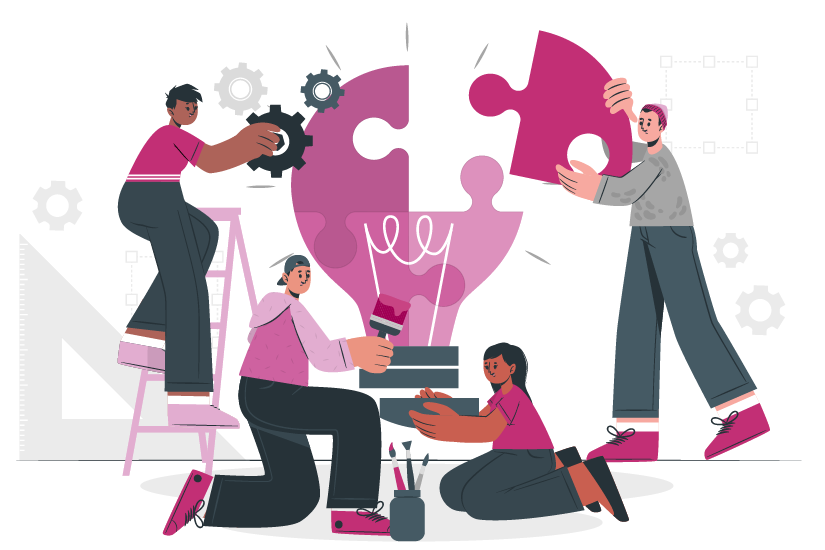A well-functioning software company requires a full-scale team model that can fulfill assigned tasks and deliver the desired quality following an estimated timeline and budget. However, this seemingly basic principle is not quite familiar to many managers, leading to inefficient team management and overlapping responsibilities.
To resolve this tackling issue, this article aims to provide 8 fundamental roles and responsibilities in project management that any manager in a software company should keep in mind!
1. Business Owner
.png)
Business owners and product managers are often mistaken since not many companies have the former position. As in the starting phase, small companies majorly focus on advertising their products and delivering them to the outside market, so the business owner has to somehow cover the product manager's responsibilities and run both roles at the same time.
So, which business model needs a business owner? Considering VNEXT Global as an example, we provide IT outsourcing services to other businesses that want to leverage their digital system.
Any business model needs a business owner, who can make critical decisions for the company and take responsibility in orienting and seeking for potential clients and partnerships. A business owner works at an abstract business level by recognizing the business issues, their solutions and critical evaluation on its success based on detailed metrics.
The business owner is also responsible for negotiating the conditions of the collaboration or determining the price of a new product. In addition, the firm owner typically oversees the viability of the new initiative itself. This involves, for instance, determining whether the solution is legal and whether the company may face future legal issues due to patent infringement or an illegal market strategy.
Keeping track of the business KPIs and key performance indicators after the project is complete is sometimes overlooked, but crucial. There are no flawless products. Each has its own weaknesses. It is essential for the business owner to monitor these indicators in order to enhance the product and adapt to potential market shifts. This might be as basic as collecting data on how users utilize website filters; this provides insight into what people are genuinely seeking.
Business owners and product managers collaborate closely to develop a concept that can be implemented by a technical team.
2. Product Manager
.png)
The product manager can be viewed as intermediary between business owners and development teams. Typical responsibilities of product managers include, among others, the prioritization of activities, the support of non-technical teams such as marketing and content, and the collection of feedback.
The product manager is responsible for transforming ideas and concepts into goods or features for the organization, making their position crucial. As they must coordinate across multiple teams within a corporation, it is sometimes a difficult position. Each team believes that its requirements are crucial to the company's success and will exert significant pressure on product managers until they receive what they want.
A product manager must possess a variety of abilities in order to be effective in their profession. The necessity to interact with a variety of individuals necessitates the importance of soft skills, but technical skills are also essential since they will define to some extent how and when things will be executed. This does not imply that they must have a background in engineering, but they must have a thorough understanding of technology in order to make rapid assessments and deliver prompt responses to stakeholders.
Product managers are frequently tasked with preparing a product's roadmap and ensuring that the product meets the requirements of its users. It is crucial that this task is completed correctly so that the development teams remain occupied and provide value for the organization. Product managers and development teams must have a thorough understanding of technical debt and the frequency of consolidation sprints/iterations in order to achieve success. Don't worry if you don't grasp certain topics, such as technical debts or sprints/iterations, as they will be discussed in greater depth later.
Product managers are responsible for writing user stories every day, which are brief summaries of use cases typically based on the needs of the consumers. Additionally, product managers typically provide the approval criteria. Essentially, they describe how a feature can be deemed complete. Typically, quality assurance (QA) teams rely on the acceptance criteria of a user story to determine whether the implementation meets the required standards. It is also common that at the conclusion of the implementation and verification cycles, the product manager verifies that the user stories meet the previously specified requirements; in other cases, QA is solely responsible for the approval, depending on the maturity of the teams or even the company.
3. Project manager
.png)
In addition to the product manager, who is typically regarded as the "CEO" of the project and is in charge of the project life cycle, the project manager acts as the COO of the project, overseeing the work, the project from beginning to end, and ensuring the correct implementation of the given requirements.
They concentrate on technology, request, time, and cost (cost). In outsourcing organizations, the job of Project Manager is typically unique.
The project manager is in charge of "How" and "When":
- What is the project's budget?
- Where are the resources?
- How can requests be made?
- When will the project be finished?
4. Designers

Design may be required depending on the user stories or features provided by the product managers. Designers are vital because they are not only responsible for building the interfaces with which consumers will engage, but also for giving a product or firm a consistent identity across all platforms. They serve as a connection between users and the technology a product exposes.
Design teams are tasked with understanding how people interact with the products and taking this into consideration when creating them.
The interaction with a product comprises how people will use or, if the product is already available, are using the product, including clickable elements, transitions, states, and drag-and-drop capabilities, among others.
Consistency between elements should also be considered; all clickable buttons should share the same color or shape. Examples of elements requiring consistency include a heart-shaped button for something that can be "liked," a plus sign for adding an item to a list, and arrows for navigating multiple input fields.
Design teams collaborate closely with development teams to determine what is feasible for execution, how long it may take, whether server-side calls require a waiting animation, etc.
Given that every product is multi-platform today—different browsers, mobile versions on different screen sizes, and mobile applications on different operating systems—it can be difficult to maintain product consistency, as design may conflict with operating system guidelines, resulting in applications being rejected by certain vendors. This is something that designers frequently deal with; nonetheless, it is part of their job, so they must accept this reality and conquer these obstacles in the most resourceful manner possible.
When discussing design, two important terms frequently appear: UI and UX (user interface and user experience). They are occasionally confused and misunderstood, but they are simple to explain. UX focuses mostly on the interaction a user has with a product (experience), such as what and when something can be clicked, how the user is notified when an action is complete, etc. UI is primarily concerned with aesthetics, branding, and consistency; hence, interface. Consider it as the vest or skin of a product. Depending on the size of the business, multiple individuals may perform each task. Even midsize organizations tend to hire individuals with knowledge in both fields, as there is sometimes no room for a dedicated UX specialist.
Once the drawings for a particular user narrative are complete, they are forwarded to the product manager for approval. Throughout this process, there will be multiple interactions between the product management, design, and development teams until a final choice is made and passed on to the development teams for further implementation.
Read more: 8 Main Roles and Responsibilities In Project Management (Part 2)
Final thoughts:
If you are looking for a trusted IT partner, VNEXT Global is the ideal choice. With 14+ years of experience, we surely can help you to optimize your business digitalization within a small budget and short time. Currently, we have 400+ IT consultants and developers in Mobile App, Web App, System Development, Blockchain Development and Testing Services. We have provided solutions to 600+ projects in several industries for clients worldwide. We are willing to become a companion on your way to success. Please tell us when is convenient for you to have an online meeting to discuss this further. Have a nice day!












